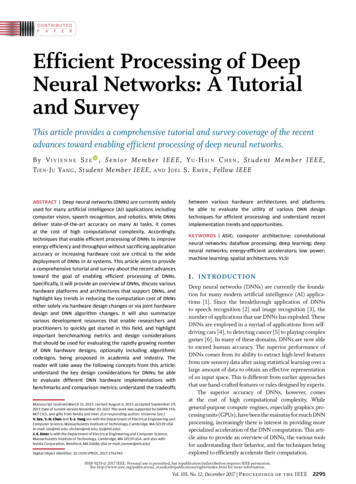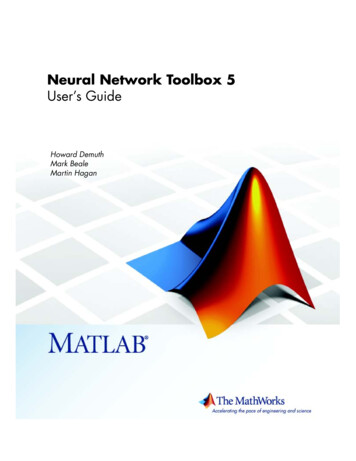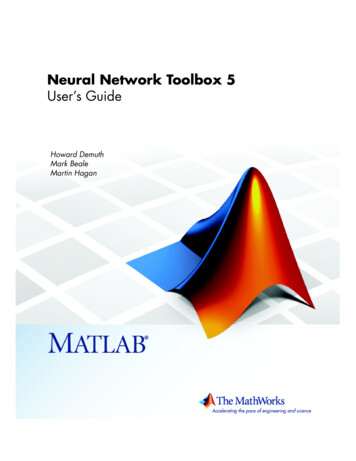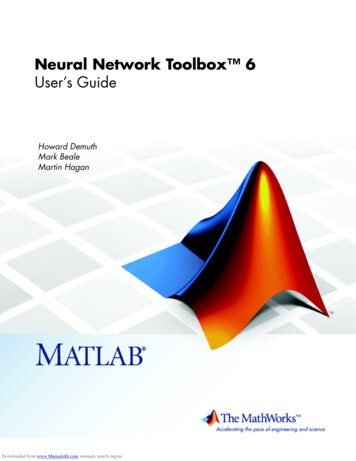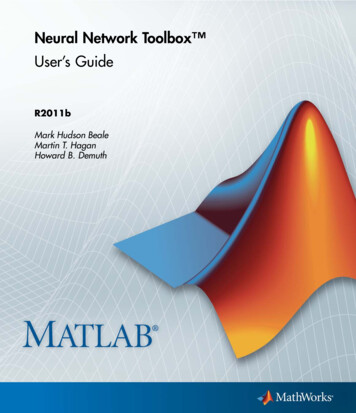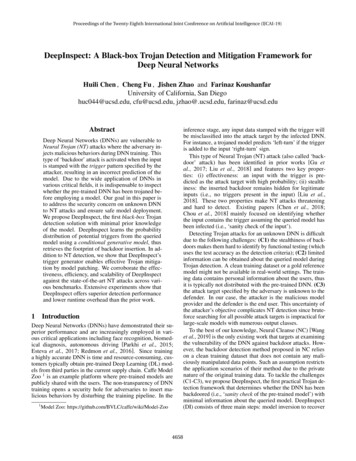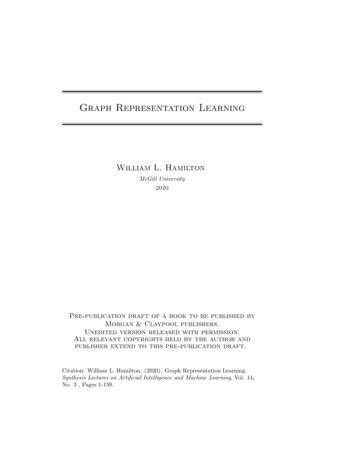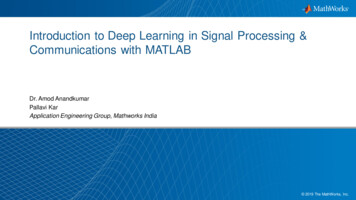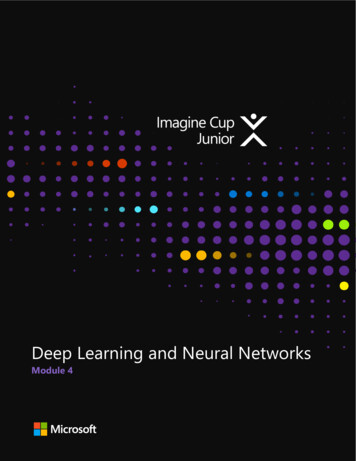
Transcription
Deep Learning and Neural NetworksModule 4
Table of ContentsLearning Outcomes . 5Review of AI Concepts . 6Artificial Intelligence . 6Supervised and Unsupervised Learning . 6Artificial Neural Networks . 8The Human Brain and the Neural Network . 9Machine Learning Vs. Neural Network . 11Machine Learning vs. Neural Network Comparison Table (Educba, 2019) . 12Conclusion – Machine Learning vs. Neural Network . 13Real-time Speech Translation . 14Uses of a Translator App . 16Network Topologies . 16Feed-forward Neural network . 16Recurrent Neural network . 16Introduction to Deep Learning . 17Deep Learning v/s Machine Learning . 18Activation functions for Deep Learning. 19Applications areas for Deep Learning . 20Programming for Deep Learning . 20Fundamentals of Keras and Using Keras for Deep Learning. 20Fundamentals of TensorFlow and using it for Deep Learning . 20Convolutional and Recurrent Neural Network . 21Introduction to Convolutional Neural Network . 21Recurrent Neural Network . 22Applications of Deep Learning . 24Introduction to Computer Vision . 242
Object/Image classification using OpenCV Library . 25Step 1 – Pre-processing. 25Step 2 – Splitting the dataset . 25Step 3 – Building a Convolutional Neural Network. 25Natural Language Processing – Sentiment Analysis. 26Practical Assignments/Lab Work . 27Questions to Ponder Upon . 28Links for Further Reading . 29References . 30Glossary . 333
Disclaimer:The Imagine Cup Junior guides and lesson materials are created by Microsoft and our partnersand intended to be for guidance only to support with the Imagine Cup Junior Challenge. ForLearningthe latest on Microsoft AI please visit https://www.microsoft.com/en-us/aiOutcomes4
This module will help students recap the topics studied in the previous modules such asartificial intelligence and machine learning. It also focuses on the basics of Keras andTensorFlow, both of which are used in the programming of Deep Learning applications.The module touches upon the topic of neural networks – both artificial and human. It helpsstudents to understand how the artificial network functions and the ways it trains itself tomimic human-like thought process. It focuses on activation functions and various otherapplications of deep learning. After the completion of this module, students will be able to Recall the basics of AI-related concepts.Understand supervised and unsupervised machine learning.Conduct a mapping of the various learnings that are classified under supervised andunsupervised machine learning.Comprehend the concept of working of the human brain and its similarities with the artificialneural network.Develop a working understanding of the neural network applications.Understand the similarities between deep learning and artificial intelligence.Appreciate the similarities and differences between machine learning and deep learning.Understand the basic programming structure required for languages suitable for deep learning.Appreciate the differences and the uses of convolutional and recurrent neural networks.Comprehend the working of sentiments analysis via natural language processing.Fundamentals of Artificial Neural Network5
Review of AI ConceptsIn earlier modules, we learnt about the different aspects of artificial Intelligence. In this modulelet us recap very briefly terms such as artificial intelligence, supervised learning andunsupervised learning.Artificial IntelligenceArtificial Intelligence (AI) is defined as the ability of a digital computer or computer-controlleddevice to perform tasks commonly associated with intelligent beings (Copeland, 2019). Wehave learnt in earlier classes that machines using in-built experiences that show a level ofreasoning, learning capabilities, and discovering meaning and context are characteristics sotypical of humans that they get labeled as machine learning capabilities. Artificial Intelligenceas a science enables machines to carry out complex tasks with minimal human intervention inscenarios which may be threatening to the human life or are too complex or take too muchtime to solve by human beings.Two examples of artificial Intelligence that can be observed in daily life are: face recognitionand its subsequent labeling on social media, and booking a taxi through a mobile applicationby detecting your location and the closest taxi available.Supervised and Unsupervised LearningA very prominent free programming language that is used for statistical computing is RProgramming Language. Supported by the R Foundation for Statistical Computing, thelanguage is used mainly by data miners and people who have expertise in statistical and dataanalysis. Although the R programming language has a command line interface, there are6
Graphical user interfaces (GUIs) for it, for example the R-Studio, which work on an integrateddevelopment environment similar to Python.Supervised learning is said to take place when both input and output variables are given, aswell as an algorithm to help the machine map the progression from input to output. Thesingular goal of this kind of learning can ensure that the algorithm is well mapped in order thatany new input would generate the correct output. A typical example of supervised learning wecan observe in real life is in medical diagnosis.Unsupervised learning is said to occur when we only have the input data but no output data.Here, there is no algorithms to recognize the patterns between input and output and as suchshow the machine how to process subsequent input data. In other words, the machine is lefton its own to create a model algorithm based purely on the input data. Unsupervised learningis based purely on input data and the machine learns by itself from the diverse data it receives.Examples can be found in systems such as visual recognition, robotics and identifying humanbehavior.Artificial intelligence is being used in various ways for the improvement of society using suchtechniques as gaming, natural language processing, expert systems, and vision systems tocomprehend and describe visual computer input. It is also used in disciplines such as speechand handwriting recognition in designing devices which can follow human speech-basedinstructions.7
Artificial Neural NetworksBy now we all know that machine learning is a subset of artificial intelligence, an area of sciencewhich enables a machine to learn from experience without having a person to program themachine explicitly. This enables the machine to learn from experience by simultaneouslyupgrading itself in terms of the learning complexities it encounters.Whilst there are many models and algorithms that can be used for machine learning, thesuitability of the model or algorithm is entirely based on the data used and the expectedoutcome. It is important that the models be understood to ensure ease of usability. In themachine learning domain, tasks can be classified into clear categories based on the way thelearning is carried out. Two very well-known categories are Supervised learningUnsupervised learningInspired by the way the brain works and the structure of the brain, scientist have developed theconcept of the neural network. The brain consists of small units known as neurons. Theseneurons communicate with each other to pass on information via something called synapses.Neural networks work in a similar way. In reality, a neural network is a group of algorithmswhich pass data between each other as it is processed. Such neural networks form a part ofdeep learning technologies.8
The Human Brain and the Neural NetworkFig 4.1: Similarities between a human brain and neural networkThe human brain receives and transmits information via nerve cells (neurons). The human brainconsists of many billions of neurons to form an elaborate network like structure. It is estimatedthat an average human brain consists of 86 billion neurons. The neurons in this dense networkwork in collaboration to ensure that the information needed to be passed on to the desiredplace, such as the muscle in your heart, is completed with the maximum speed and accuracy inorder to allow your heart to pump at a particular rate depending on how much blood yourbody needs to be circulating at any one time.9
Fig 4.2: A neuron of the human brainA neuron consists of three distinct parts: a cell body, a dendrite, and an axon. The cell body isthe largest part of a neuron and consists of the nucleus and cytoplasm. Dendrites areextensions that are responsible for receiving messages from other neurons, and the axon isthat part of a neuron that is responsible for sending the signals. These nerve cells pass on theinformation as electrical impulses to the adjacent cells via the synapse.Fig 4.3: Artificial neuron of the neural networkA similar concept is adopted for algorithms in machine learning. The ‘neurons’ in the neuralnetwork are artificially created in a computer and joined to other such ‘neurons’ present in the10
network. This creates the neural network. The artificial neuron imitates the working of abiological neuron.Machine Learning Vs. Neural NetworkMachine learning is defined as a set of algorithms that analyzes the data fed into the systemand learns from the data to make informed decisions. However, a neural network is anadvanced algorithm that can be used for machine learning with the in-built capability to learnand apply further. Whilst machine learning may require human intervention in some formespecially when it encounters inaccuracy at any stage, a neural network will learn from itsinaccuracies and take intelligent decisions on its own to rectify the same. A case in point is theNNI (Neural Network Intelligence) which is a toolkit designed to help users who run automatedmachine learning (AutoML) experiments (JiayueHu and Minewiskan, 2018).Fig 4.4: Multiple layers of a neural network (Image Source: (Marcus, 2018)From an architecture point of view, a general neural network would consist of three layersnamely the input layer at the start, the hidden layers in between and the output layer at theend.11
Machine Learning vs. Neural Network Comparison Table (Educba, 2019)AreasMachine LearningNeural NetworkDefinitionMachine Learning is a set ofalgorithms that uses parse dataand learns from the parsed dataand use those learnings to discoverpatterns of interest.Neural Network or Artificial NeuralNetwork is one set of algorithmsused in machine learning formodeling the data using graphs ofNeurons.SkillsRequired toLearnProbability and StatisticsProbability and StatisticsProgramming SkillsData modelingData structures and AlgorithmsProgramming skillsKnowledge about machinelearning frameworksData structures and algorithmsBig data and HadoopLinear algebra and graph theoryAppliedAreasExamplesMathematicsHealth CareFinanceRetailHealth CareE-commerceRetailingOnline recommendationsMachine learningTracking price changesArtificial IntelligenceBetter customer service anddelivery systemsStock Exchange PredictionSiri, Bing Maps and Bing Search,etc.Image Recognition, ImageCompression, and Search enginesetc.Table 4.1: Comparison between Machine Learning and Neural Networking12
Fig 4.5: Diagrammatic Representation of Differences between Machine Learning& Neural NetworkConclusion – Machine Learning vs. Neural NetworkWhilst machine learning can be understood as the basic or the core discipline, neural networksor deep learning can be considered as a notch higher in terms of complexity whereby itenables the machine to ‘think like a human’ making intelligent and well-informed decisions.It falls under the same field of Artificial Intelligence, whereby Neural Networks are a subfield ofMachine Learning. Machine learning serves mostly from what it has learned, whereby neuralnetworks are deep learning that powers the most human-like intelligence artificially. We canconclude by saying that neural networks or deep learning are the next evolution of machinelearning. The technology enables the machine to learn from the past decisions and make itsown decision without human intervention at any level in any form.13
Real-time Speech TranslationHave you ever seen an ongoing session of the UN General Assembly or European Parliamenton the television or video? You will see that many members wear headsets during the session.The headsets are a part of an Interpretation Service which provides the member with real timetranslation services.The staff of the Interpretation Service are thus responsible for ensuring that members, andothers, present at a meeting are able to understand what is being said, and at the exact timethat they are speaking. They provide simultaneous interpretation from and into the officiallanguages for meetings.Fig 4.6: UN Members using headphones during the General Assembly sessionSource - (Haughton, 2019)One of the biggest challenges that a linguistically distinct team may face in such a scenario isthat of the language. However, it is no longer a challenge anymore as real time speechtranslation services tend to act as ‘go-to medium’ for people to hold a conversation usingdifferent languages.14
Fig 4.7: Words being interpreted by others in their own languages using the translator app Source - (Microsoft and Hughes,2016)Language is the thing that bonds us all together and one of the most successful ways AI helpshumankind is by removing the barrier of language between people of difference nationalities.Microsoft Translator, and similar products, have been created with the aim of breaking thelanguage barrier and creating a personal interpreter for people who travel often or meetpeople from other cultures speaking different languages.15
Uses of a Translator AppWhilst a primary function of a translator can translate text entered into a text box in the desiredlanguage, they also accomplish the following goals: Enable participants to share experiences in their native language.Teachers are able to present to a wider audience.Enables easier travelling and in meeting people internationally.Make people feel welcome.Of course, the translator system not only receives input as text but as mentioned earlier canextract text from images and voice and also output as such. This means an entire conversationcan be held verbally between two or more people who don’t speak the same language.Network TopologiesNetwork topology is the structure of a network and may be depicted physically or logically. It isan application of graph theory where communicating devices are modeled as nodes on thenetwork and the connections between the devices are modeled as links or lines between thenodes. There are two major types of network topology:Feed-forward Neural networkA feed-forward neural network is an artificial neural network where connectionsbetween the nodes do not form a cycle. Therefore, it is different from recurrentneural networks. The feed-forward neural network was the first and simplest form ofartificial neural network developed.Recurrent Neural networkA recurrent neural network (RNN) is a type of artificial neural network commonlyused in speech recognition and natural language processing (NLP). RNNs are16
designed to recognize a data's sequential characteristics and use patterns to predictthe next likely scenario.Introduction to Deep LearningDeep Learning is a subfield of machine learning concerned with algorithms inspired by thestructure and function of the brain and relies on neural networks. Andrew Yan-Tak Ng, a ChineseAmerican computer scientist and statistician who specializes in machine learning and AI, is of theopinion that “Deep learning has taken off like crazy is because it is fantastic at supervisedlearning. Almost all the value today of deep learning is through supervised learning or learningfrom labeled data”. In other words, a deep learning neural network primarily needs enormousamounts of labeled data and a quality supervised machine learning algorithm appropriateenough to generate the desired results.The Deep Learning subset of AI is based on algorithms inspired in structure by components andthe working of the human brain. Whilst many of you may confuse it with a neural network, thereis a deeper connection. You have read in the earlier modules that supervised learning is therecommended form of machine learning as it tells the machine what needs to be done and how.The entire path is defined for the machine to study, learn and follow.However, deep learning is different as the algorithms used have an in-built learning capability.These algorithms work on similar processes to those in human brains, such as being able toidentify connections between the data points, learn on their own, and find out what can be doneto arrive at the result, even when the data is unsupervised.Deep learning algorithms are programmed to do what we as humans are programmed naturallyto do internally. The ability to learn by example is inherent in humans and at times, we humansmay not be able to achieve the accuracy that a machine may be able to deliver. The deep learningalgorithms are able to use unsupervised data to form a pattern, and are programmed in theinitial (training) stages by large sets of labeled data and many, multi-layered, neural networkarchitectures.17
Deep Learning v/s Machine LearningMachine Learning is a set of algorithms that have the capability to analyze the data provided,learn from that data, and apply what is learnt to make intelligent decisions. Many prominentexamples can be found on social media, and photo storage platforms which are capable ofidentifying people from unloaded images, or recommending movie and television programbased on what you have watched via a streaming app. This learning is based on the past actions,selections and preferences of the user. Machine learning may need human intervention at timesand tend to perform limited tasks for what they have been programmed as it does not thinkbeyond the realms of what it has been programmed for and subsequently learnt to do withinthose realms.Deep learning contains a complex hierarchy of concepts, each one defined and related to theother in some form of the other. The development of a deep learning technique involves theprocessing of the data through various layers through a step-by-step process. Among thevarious benefits of using deep learning techniques, the two most prominent ones are: Scalability - ability of a computing process to be used across a range of applications.Feature Learning - ability to perform automatic feature extraction from raw dataDeep learning machines tend to require enormous amounts of data as well as high-endcomputers to generate the desired results. A graphics processing unit, or GPU, is also anintegral part of a deep learning system in order to process images in parallel withcomputations on data.Whilst both machine learning and Deep Learning are subsets of AI, their approaches to solvinga problem are completely different from each other. Let us see how. Here is an imagecontaining a mixture of cats and dogs.18
Fig 4.7: A collective image of dogs and cats (Image Source: Kaggle)The algorithm which machine learning uses labeled, or structured data, which contains all theproperties of the animals in order for it to be able to identify the individual figures in theimage. However, the approach of the deep learning algorithm is slightly different. Thealgorithm will still be able to identify the individual figures in the image using various hiddenlayers in the algorithm. These layers contain the key to the properties of the animals to theimage and thus can deal or respond to the unsupervised data.Activation functions for Deep LearningActivation functions are an extremely important feature of the artificial neural networks. Theybasically decide whether a neuron should be activated or not and whether the information thatthe neuron is receiving is relevant to the given information or if it should be ignored.The activation function is a non-linear transformation mathematical function that is executedon the input data. Once this step is performed, the output generated is then sent to the nextlayer of neurons as its input.19
To know more about the subject you can click on the following link use-them/Applications areas for Deep LearningWhilst deep learning may sound like an advanced concept, the fact is that it is very much areality and has many day-to-day applications. Deep learning applications are applied in thefollowing areas: Self-driving automobilesNLP (Natural Language processing)Fraud detection in the Banking sectorRestoration of colors in vintage images and videosDisease diagnosis in healthcareProgramming for Deep LearningFundamentals of Keras and Using Keras for Deep LearningKeras is a high-level neural network API (Application Programming Interface), written in Pythonand capable of running on top of machine learning library and production environments suchas TensorFlow, CNTK, or Theano. It was developed with a focus on enabling fasterexperimentation.Keras uses a library, called the "Backend”, to do calculations. Backend is a term in Keras thatperforms all low-level computation.Fundamentals of TensorFlow and using it for Deep LearningTensorFlow is an open-source machine learning library for research and production.TensorFlow offers APIs for beginners and experts to develop machine learning models fordesktop, mobile, web, and cloud.20
Convolutional and Recurrent Neural NetworkIntroduction to Convolutional Neural NetworkA Convolutional Neural Network (ConvNet/CNN) is a deep learning algorithm which can takeinput in the form of images. The algorithm is designed to assign ‘importance’ to variousobjects in an image (based on learnable influencers and biases) in order to differentiatebetween those images. It is important to note that in the primitive methods of learning, filtersare often human based. However, when it comes to CNN, filtering is a machine-based ability,or trait, that it develops.The architecture of a CNN is quite similar to that of the human brain. The connectivity patternsof the neurons are similar to the human brain and the entire organization framework is inspiredby the Visual Cortex. Each of the neurons tend to react to a response by the stimuli, however,the response works only in a restricted environment of the visual periphery. This boundary isknown as the Receptive Field. A collection of receptive fields tend to overlap to cover the entirevisual area.Fig 4.8: A Diagrammatic Representation of the Convolutional Neural NetworkThe visual cortex consists of small cells that are sensitive to the local area of the visual field andresponded only when they were in the presence of certain stimuli.21
Fig 4.9: 3 color channelsRecurrent Neural NetworkRecurrent Neural Networks (RNN) are a class of enhanced neural networks that exhibittemporal (time-based) dynamic behavior. This means it is designed specifically to retain thelearning of what it was taught and use it repeatedly in the future. It is common for any neuralnetwork to remember what it has learnt and replicate it whenever necessary, thus creatinglearning through experience. The RNN can also remember what the machine learnt during anyprior input or during production of the output. Hence, in case of an RNN standard learningprocedure, the model may, or may not, reproduce a different result having been influenced byprevious inputs.Architecture Framework of the Recurrent Neural Network22
Fig 4.11: Framework of the Recurrent Neural Network23
Applications of Deep LearningIntroduction to Computer VisionFig 4.11: A visual representation of Computer VisionCredit: Steven Lewis (Image Source: https://unsplash.com/photos/r4He4Btlsro)The ability to look at things and perceive them as objects we define is a quality that makes usunique. Human beings look and understand the value and meaning of many objects and indifferent contexts. Computer vision is similar. It is defined as the ability of a machine to be ableto capture, identify and process images.From the human perspective, recognizing objects around us is not difficult but from theperspective of a machine it is difficult. This is because it does not have the expertise and assuch needs to build that expertise from scratch. Once created, the machine can revisit data ithas learnt from data points provided over time in order to arrive to a conclusion based on theinputs.OpenCV, or Open Source Computer Vision library, originally started out as an Intel researchproject and is the largest computer vision library to date as it contains a massive amount of24
computer functions that can be used to program machines. It contains an implementationbased bank of more than 2500 algorithms. These libraries are free to use and are often used forboth commercial and academic purposes. One of the many features of OpenCV is that thelibrary has interfaces for languages which include Python, Java, and C . In other words, it is arobust platform that can create any application using in any of the languages. The first OpenCVversion, 1.0, was released in 2006 and the OpenCV community has grown since then.Object/Image classification using OpenCV LibraryThe process of classifying images as separate groups to facilitate labeling is called classificationof the images. The process of object categorization programs the classifier to recognizecategories of objects using only the images which have been retrieved automatically. Theprocess is extensive and is carried out in 3 steps.Step 1 – Pre-processingThis step begins by making the images noise free. It uses processing pre-processingthe images to clear the slightest hint of noise in them.Step 2 – Splitting the datasetIn this step a small batch of images are used during various iterations of theoptimizer. This speeds up the training time required.Step 3 – Building a Convolutional Neural NetworkThis step can have 3 convolution layers with 2 x 2 max-pooling. Max-pooling isprimarily a technique which is used to reduce the dimensions of a given image bytaking the maximum pixel value of a grid. In other words, 2x2 pixels25
Natural Language Processing – Sentiment AnalysisRecall a time when you last communicated with someone on social media and used anemoticon rather th
Machine Learning Vs. Neural Network Machine learning is defined as a set of algorithms that analyzes the data fed into the system and learns from the data to make informed decisions. However, a neural network is an advanced algorithm that can be used for machine learning with the in-built capability to learn and apply further.


